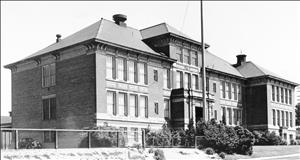This history of Jefferson School is taken from the second edition of Building for Learning: Seattle Public School Histories, which includes histories of every school building used by the district since its formation around 1862. The original essay was written for the 2002 first edition by Nile Thompson and Carolyn J. Marr, and updated for the 2024 edition by HistoryLink editor Nick Rousso.
At the Junction
The West Seattle Junction got its name in 1907 when two streetcar lines connected at California Avenue and Alaska Street, forming a junction. Within three years, this neighborhood was booming and classrooms at West Seattle School were overcrowded. Responding to this growth, the Seattle School Board investigated sites for a new school in 1911. The working name was West Seattle Junction School. Edgar Blair, the district architect, was instructed to draw up duplicate plans for this school and Ravenna School, to be built at the same time. When a call for bids was authorized, the West Seattle school was officially named Jefferson School in honor of Thomas Jefferson, the nation’s third president. Teachers and students were assigned to the building for the start of the 1911-1912 school year, although the school was not scheduled to open until January 1912. A number of stores in the Junction were temporarily leased as annexes to hold classes until the school opened.
Jefferson School, located one block southeast of the Junction, opened in early 1912 with 135 children in three classes for grades 1-5. “We rattled around like peas in a pod because we had so few students,” said one student of that first year. The second year the student body was expanded to grades 1-7, and, in fall 1914, the 8th grade was added. School enrollment continued to grow. In 1917-1918, Jefferson held 443 students in 13 classrooms. The grounds were enlarged, and the following September Jefferson was one of five Seattle Public Schools to utilize a Liberty Building; these were inexpensive wood-frame structures that adhered to a national policy to conserve labor and materials for the war effort. With the opening of the five-room Liberty Building, total enrollment at Jefferson rose to over 600.
E. L. McDonnell took the helm as principal in 1922 and was in that position for 25 years. West Seattle’s population continued to grow, and four one-room portables were installed to accommodate Jefferson’s increased enrollment. A 1928 addition, termed the “south wing,” contained eight classrooms and an auditorium-lunchroom. That year the grade configuration was expanded to include kindergaten. The following year the 7th and 8th grades were shifted from Jefferson to the new James Madison Intermediate School.
Influx of War Workers
In 1931, the school board was asked to sell a 90-foot strip along Alaska Street for commercial development as Jefferson was located in the heart of the West Seattle business district. Although the PTA strongly opposed the sale, the community voted in favor of the deal. The sale ultimately fell through, and the district retained the property. During World War II, West Seattle’s population boomed with the influx of workers employed in nearby shipyards and airplane industries. A nursery school was erected on the Jefferson grounds using federal funds. Enrollment continued to increase in the post-World War II years. Kindergarten enrollment grew to 175 in September 1945. One of the three full-day classes was forced to meet in the auditorium. In fall 1947, the nursery school closed, and its building was used for kindergarten classes. That year there were six kindergarten classes, but only two 6th grade classes to graduate to James Madison Junior High.
The population boom led to the construction of Genesee Hill School. Prior to its opening after the first semester in 1948, Jefferson’s 1,088 students attended school in half-day shifts. The transfer of 156 children to Genesee Hill did not solve the problem, and five portables were added to the Jefferson site from 1949 to 1955. In fall 1955, an all-portable school called Fairmount Park opened as an annex to Jefferson to relieve the overcrowded conditions.
Enrollment at Jefferson began to decline, dropping by 440 students in 1956-1961. The extra space was used for three special-education classes. From the mid-1960s to the early 1970s, the number of businesses at the Junction increased and the neighborhood population declined, resulting in fewer students in the Jefferson attendance area. Jefferson then became the school of choice for many people who brought their children with them when they came to work in the Junction. A bilingual program was added, and in 1978-1979, the school had an enrollment of 78 non-English speaking children, many recent arrivals from Southeast Asia.
The district considered closing the site due to declining enrollment. After a 1978 study established that the building needed $424,000 in renovations to bring it up to code, the school was closed. The main safety concern was potential earthquake damage. In 1982, the site was leased for 99 years. Two-and-one-half years later, the Jefferson building was demolished and replaced with a retail-residential-parking facility, commemorating the school with the name Jefferson Square.
History
Jefferson School
Location: 4720 42nd Avenue SW
Building: 8-room brick
Architect: Edgar Blair
Site: 1.69 acres
1911: Named on June 1
1912: Opened in January
1918: Site expanded to 3.16 acres
1928: Addition (Floyd A. Naramore) opened in fall
1979: Closed in June
1982: Leased in December for 99 years
1985: Building demolished on June 18
Present: Site of Jefferson Square
Jefferson Annex
Location: 4720 42nd Avenue SW
Building: 5-room, 1-story wood "Liberty Building"
Architect: n.a.
1918: Opened in fall as annex
1928: Still in use
1959: Still on site
n.a.: Closed and demolished

